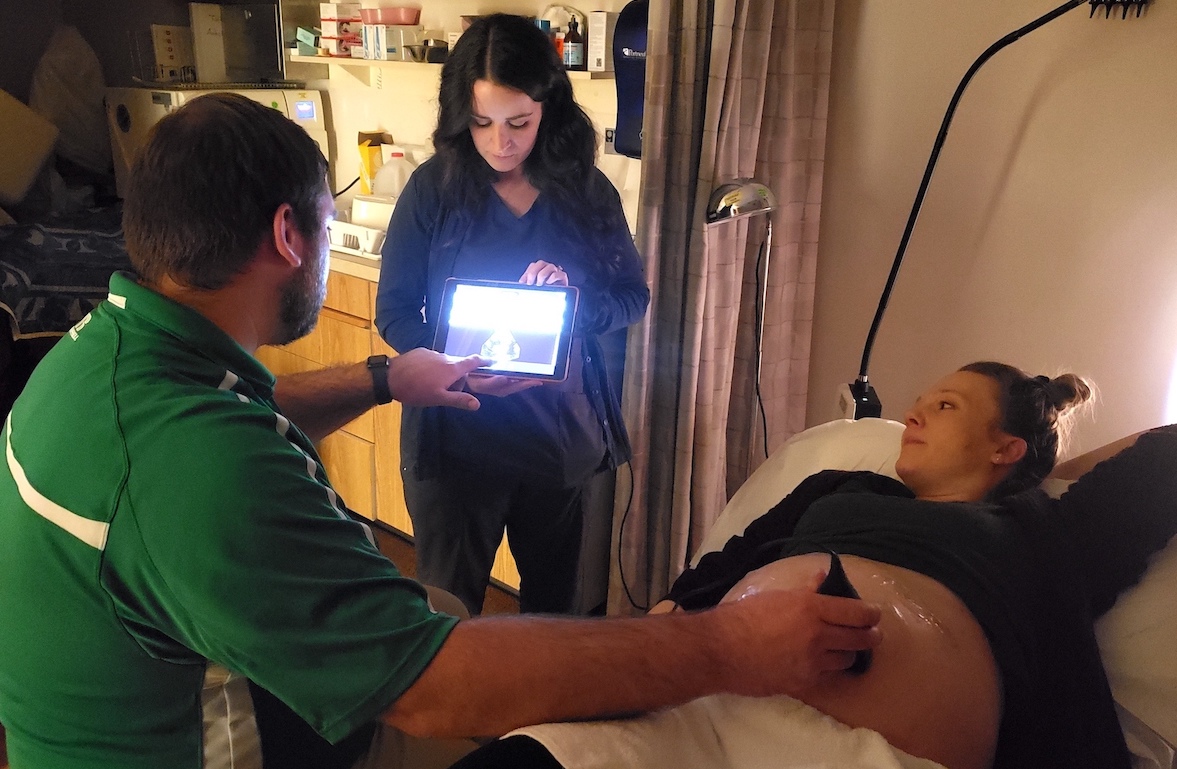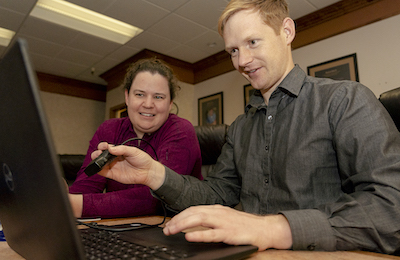Idaho State University students cross train using latest in ultrasound technology
March 10, 2020

SonoSim helping students in field that desperately needs them
POCATELLO - Through collaborative efforts between the radiographic science, Family Medicine Residency, and Physician Assistant Studies programs, Idaho State University is working hard to serve the communities of Idaho that need sonographers. Working together in this fashion is part of the ISU Kasiska Division of Health Sciences’ mission to work interprofessionally across multiple health disciplines in education, training and practice.
“Over the last few years, using ultrasound clinically has become a reality in clinical practice,” said Dave Martin, clinical associate professor and academic coordinator for the physician assistant (PA) program. “Our hope is, as PA students go out in the clinical year, they can connect with different facilities that have ultrasound, and they can move forward and become more skilled and proficient at it.”
Christopher Wertz, program director and assistant professor for radiographic science, worked with other members of his and other ISU departments, along with health care providers in the community to offer the Diagnostic Medical Sonography Certificate option. Portneuf Medical Center and Eastern Idaho Regional Medical Center are two of the major contributors to funding of the program and providing the advice of the skills needed for those taking the program.
“Applicants have to be X-ray certified first,” Wertz said. “We do that because all the facilities in the area asked us specifically for it. When we talked to them about a need for this program and trying to support it and develop it, they said, ‘you’re going to make sure they’re X-ray certified first, right?’ and we said, ‘absolutely - that’s our goal.’”
The program only accepts X-ray-certified students because of the training needed in order to work in a hospital environment, and takes a look at how students have performed in those classes before they’re accepted.
 The sonography program, a three-semester course, was approved in February 2019 and began the following summer. Wendy Mickelsen, radiographic science clinical coordinator, said the majority of the facilities in Southeast Idaho have at least one opening for a full-time sonographer. She said they are desperately needed.
The sonography program, a three-semester course, was approved in February 2019 and began the following summer. Wendy Mickelsen, radiographic science clinical coordinator, said the majority of the facilities in Southeast Idaho have at least one opening for a full-time sonographer. She said they are desperately needed.
“We have more jobs in the area than people to fill those jobs,” Wertz said.
“Most of our students are hired before they graduate,” Mickelsen added.
Mickelsen, along with Chelsea Wheatley, diagnostic medical sonography clinical assistant professor, both say that the smaller facilities – particularly in rural areas in Southeast Idaho – need sonographers who can work with X-ray, CT scans, MRI and possibly nuclear medicine.
Students in the program spend the first two weeks in a ‘boot camp,’ learning how to use the equipment. Then, students spend time at clinicals, helping patients four days a week and going to the classroom on the fifth day.
“In their third semester they actually take the physics board exam, and then as soon as they’re done they’ll be able to sit for abdomen and OB-GYN specialties,” Wheatley said.
Wheatley said they are able to help the students become more prepared for the medical environment using equipment called SonoSim, a simulated ultrasound program. The program has different modules for different parts of the body, including abdomen, breasts, genitals, ocular, pulmonary and vascular. Students are able to learn how to move the probe and get familiar with what appears on the screen, so they can focus on the patient once they start working.
“They’re already hitting the ground running when they get to clinicals, instead of trying to learn how to run when they get with patients,” Wertz said. “This helps the patient, sonographer, and the medical staff, who often confirm that students from ISU are better prepared than those from other schools.
Wheatley added that the SonoSim program – which is unique to Idaho State and all other universities in the area and state – exposes students to what real-life images would look like, and varies the circumstances based on the different patients they would come across.
“It will give you certain pathologies,” Wheatley said. “As you get a little bit further, it shows you different pathologies and what they would look like on a patient, so when you get a patient who has it, you can recognize an aneurysm, or a blood clot because you’ve seen it on the SonoSim.”
Wertz said the sonography program, which has been needed for a while, is beneficial to students because each faculty member has worked in the field and still maintains their professional contacts. This, combined with the need of sonographers, helps students secure employment opportunities.
“There’s so many different areas that our students can pursue once they’re done with their bachelor degree here,” Wertz said. “Opportunities are really endless, just depending on what they want to do and what interests them.
This has also been a good opportunity for faculty to collaborate through shared opportunities of learning.
“The nice thing is that radiographic science faculty and family medicine residents have been willing to come over and share what they know with the PA students,” Martin said.
A.J. Weinhold, associate program director in the Family Medicine Residency Program, says they’ve been getting good feedback on her end regarding the program and the equipment.
“Residents have given us positive feedback, appreciating the perspective that a sonographer brings to their teaching,” Weinhold said. “Residents have also let us know how much benefit they are already seeing from using the SonoSim and then being more comfortable doing the scan in real life in the clinic or hospital.”
Radiographic science hopes to add certificate options for MRI, CT Scan and Mammography in the future and is exploring options to develop these specialty areas.
Bottom photograph information: From left, A.J. Weinhold, associate director of the ISU Family Residency program, doing SonoSim training with Dan Sterner, DO.
Categories:
